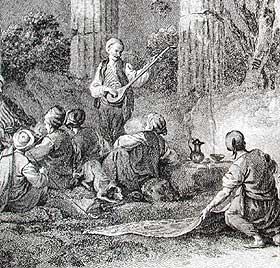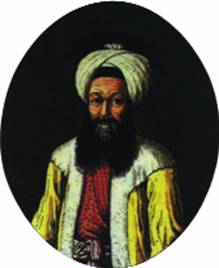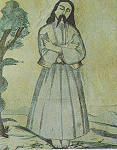|
Sefâretnâme
Sefāret-nāme (سفارت نامه), literally ''the book of embassy'', was a genre in the Turkish literature which was closely related to seyahatname (''the book of travels''), but was specific to the recounting of journeys and experiences of an Ottoman ambassador in a foreign, usually European, land and capital. Sefâretnâme were edited by their authors with a view to their presentation to the Sultan, and to his high administration, thus also bearing a semi-official character, their objective being to make them "feel" the foreign country in question, as much as informing on it. For this reason, and for the literary qualities that were sought in order to attain their objective, they remain of lasting interest for the general reader. The first example of the genre is admitted to be the Kara Mehmed Çelebi sefâretnâme, relating his embassy in Vienna in 1665. Outstanding examples of the genre, mostly dating from the 18th century, are of particular value both in lasting literar ... [...More Info...] [...Related Items...] OR: [Wikipedia] [Google] [Baidu] |
Yirmisekiz Mehmed Çelebi
Yirmisekiz Mehmed Çelebi Efendi (ca. 1670–1732), also Mehmed Efendi (sometimes spelled Mehemet Effendi in France), was an Ottoman statesman who was delegated as ambassador by the Sultan Ahmed III to Louis XV's France in 1720. He is remembered for his account of his embassy mission (a '' sefâretnâme'', "book of embassy"). Yirmisekiz Mehmed Çelebi was born in Edirne to a family of Georgianİsmail Hâmi Danişmend, ''Osmanlı Devlet Erkânı'', Türkiye Yayınevi, İstanbul, 1971, p. 60. descent. His date of birth is unknown. He was the son of an officer in the Janissary corps, Süleyman Ağa, who died during a campaign to Pécs. Mehmed Çelebi himself was enrolled in the Janissary corps, and since he had served in the 28th battalion ("'' orta''" in Janissary terminology) of the corps, he came to be known with the nickname ''Yirmisekiz'' ("twenty-eight" in Turkish) for his entire life. His descendants, including his son who became a grand vizier, also carried the name ... [...More Info...] [...Related Items...] OR: [Wikipedia] [Google] [Baidu] |
Turkish Literature
Turkish literature () comprises oral compositions and written texts in the Turkish language. The Ottoman form of Turkish, which forms the basis of much of the written corpus, was highly influenced by Persian and Arabic literature,Bertold Spuler''Persian Historiography & Geography''Pustaka Nasional Pte Ltd p 69 and used the Ottoman Turkish alphabet. The history of the broader Turkic literature spans a period of nearly 1,300 years. The oldest extant records of written Turkic are the Orhon inscriptions, found in the Orhon River valley in central Mongolia and dating to the 7th century. Subsequent to this period, between the 9th and 11th centuries, there arose among the nomadic Turkic peoples of Central Asia a tradition of oral epics, such as the '' Book of Dede Korkut'' of the Oghuz Turks— ancestors of the modern Turkish people—and the '' Epic of Manas'' of the Kyrgyz people. Beginning with the victory of the Seljuks at the Battle of Manzikert in the late 11th centu ... [...More Info...] [...Related Items...] OR: [Wikipedia] [Google] [Baidu] |
Giritli Ali Aziz Efendi
Giritli Ali Aziz Efendi (1749, in Kandiye (Heraklion) – 29 October 1798, in Berlin) was a late-18th century Ottoman ambassador and author. He is best known for his novel "Muhayyelât" (''Imaginations''), a unique work of fiction blending personal and fantastic themes, well in the current of the traditional Ottoman prose, but also exhibiting influences from Western literature. Biography Ali Aziz Efendi was born in 1749 in Kandiye (Crete) as the son of ''Tahmisçi'' Mehmed Efendi, who was the defterdar of the Crete Eyalet.Zeynep Uysal, ''Olağanüstü Masaldan Çağdaş Anlatıya: Muhayyelat-ı Aziz Efendi'', Boğaziçi Üniversitesi Yayınevi, 2006, p. 1. The details on his life are rather sparse and scattered. He rose through the Ottoman hierarchy and was sent as ambassador to Prussia in 1796 and he died in Berlin in 1798. His burial marked also the opening of the first Turkish or Muslim cemetery in Berlin. Muhayyelât Consisting in three parts and written in a laconical ... [...More Info...] [...Related Items...] OR: [Wikipedia] [Google] [Baidu] |
Ahmed Resmî Efendi
Ahmed Resmî Efendi (English, "Ahmed Efendi of Resmo"), also called by some Arabic sources as Ahmed bin İbrahim Giridî ("Ahmed the son of İbrahim the Cretan"), was an Ottoman Greek statesman, diplomat and author of the late 18th century. In international relations terms, his most important – and unfortunate – task was to act as the chief of the Ottoman delegation during the negotiations and the signature of the Treaty of Küçük Kaynarca. In the literary domain, he is remembered for various works among which his sefâretnâme recounting his embassies in Berlin and Vienna occupy a prominent place. He was Turkey's first ever ambassador in Berlin. Early life Ahmed Resmi was born into a family of Greek descent in the Cretan town of Rethymno, which was known as Resmo in the Ottoman Empire in the year 1700. According to Muhammed Muradî, the source for the little that is known concerning his early life, Ahmed Resmî arrived in İstanbul towards his forties, in 1734. Most sou ... [...More Info...] [...Related Items...] OR: [Wikipedia] [Google] [Baidu] |
Ottoman Literature
Turkish literature () comprises oral compositions and written texts in the Turkish language. The Ottoman Turkish, Ottoman form of Turkish, which forms the basis of much of the written corpus, was highly influenced by Persian literature, Persian and Arabic literature,Bertold Spuler''Persian Historiography & Geography''Pustaka Nasional Pte Ltd p 69 and used the Ottoman Turkish alphabet. The history of the broader Turkic literature (other), Turkic literature spans a period of nearly 1,300 years. The oldest extant records of written Turkic languages, Turkic are the Orkhon script, Orhon inscriptions, found in the Orkhon Valley, Orhon River valley in central Mongolia and dating to the 7th century. Subsequent to this period, between the 9th and 11th centuries, there arose among the nomadic Turkic peoples of Central Asia a tradition of Oral literature, oral Epic poetry, epics, such as the ''Book of Dede Korkut'' of the Oghuz Turks— ancestors of the modern Turkish people— ... [...More Info...] [...Related Items...] OR: [Wikipedia] [Google] [Baidu] |
Kara Mehmed Çelebi
Kara or KARA may refer to: Geography Localities * Kara, Chad, a sub-prefecture * Kára, Hungary, a village * Kara, Uttar Pradesh, India, a township * Kara, Iran, a village in Lorestan Province * Kara, Republic of Dagestan, a rural locality in Dagestan, Russia * Kara, Sardauna, a village in Sardauna, Nigeria * Kara, Bougainville, a town on Bougainville Island in Papua New Guinea * Kara, Togo, a city in northern Togo ** Kara Region ** Roman Catholic Diocese of Kara, Togo * Gaya confederacy or Kara, a former confederation in the southern Korean peninsula * Kara crater, a meteorite crater in northern Russia Rivers, Seas * Kara (river), a river in northern Russia, flowing into the Kara Sea * Kara River (other), other rivers named Kara * Kara Lake, Bolivia * Kara Sea, a sea in the Arctic Ocean * Kara Strait, a strait in Russia People * Kara (name), a surname and given name, and a list of people with the name * Kara people, an ethnic group in South Sudan, exceeding 100,0 ... [...More Info...] [...Related Items...] OR: [Wikipedia] [Google] [Baidu] |
Russia
Russia, or the Russian Federation, is a country spanning Eastern Europe and North Asia. It is the list of countries and dependencies by area, largest country in the world, and extends across Time in Russia, eleven time zones, sharing Borders of Russia, land borders with fourteen countries. Russia is the List of European countries by population, most populous country in Europe and the List of countries and dependencies by population, ninth-most populous country in the world. It is a Urbanization by sovereign state, highly urbanised country, with sixteen of its urban areas having more than 1 million inhabitants. Moscow, the List of metropolitan areas in Europe, most populous metropolitan area in Europe, is the capital and List of cities and towns in Russia by population, largest city of Russia, while Saint Petersburg is its second-largest city and Society and culture in Saint Petersburg, cultural centre. Human settlement on the territory of modern Russia dates back to the ... [...More Info...] [...Related Items...] OR: [Wikipedia] [Google] [Baidu] |
Travel Books
The genre of travel literature or travelogue encompasses outdoor literature, guide books, nature writing, and travel memoirs. History Early examples of travel literature include the ''Periplus of the Erythraean Sea'' (generally considered a 1st century CE work; authorship is debated), Pausanias' ''Description of Greece'' in the 2nd century CE, ''Safarnama'' (Book of Travels) by Nasir Khusraw (1003-1077), the '' Journey Through Wales'' (1191) and '' Description of Wales'' (1194) by Gerald of Wales, and the travel journals of Ibn Jubayr (1145–1214), Marco Polo (1254–1354), and Ibn Battuta (1304–1377), all of whom recorded their travels across the known world in detail. As early as the 2nd century CE, Lucian of Samosata discussed history and travel writers who added embellished, fantastic stories to their works. The travel genre was a fairly common genre in medieval Arabic literature. In China, 'travel record literature' () became popular during the Song dynas ... [...More Info...] [...Related Items...] OR: [Wikipedia] [Google] [Baidu] |
Letters From Turkey
Letters from Turkey were a genre of letter collection written by Europeans who had been to Ottoman Empire. Usually, the letters were published with various titles, but they are popularly known as "Letters from Turkey" or "Turkish letters". Below is the summary of these. Letters by Busbecq Ogier Ghiselin de Busbecq (1522–1592) was a diplomat in the Holy Roman Empire. He was sent to the Ottoman Empire to discuss the disputed territory of Transylvania (modern west Romania) in 1554. During his stay his addresses were Rüstem Pasha and Semiz Ali Pasha both of which were grand viziers. Upon returning to his country he published the letters he had written to his colleague Nicholas Michault under the title ''Turcicae epistolae''. Busbuecq is also known for his introduction of tulip, from Turkish flora to Europe. Letters by Montagu Lady Mary Wortley Montagu (1689–1762) was the wife of Edward Wortley Montagu, the British ambassador to Ottoman Empire between 1716-1718. The letters ab ... [...More Info...] [...Related Items...] OR: [Wikipedia] [Google] [Baidu] |
Osman Aga Of Temesvar
Osman Ağa of Temeşvar (; 1670–1725) was an Ottoman army officer, historian, and travel writer, as well as one of the few Turkish-language autobiographers of the era. The former prisoner-of-war wrote mostly of his adventures - and imprisonment - in Habsburg Austria. His autobiography was the sole Ottoman Turkish example of its kind. Life Osman was born in Temeşvar (Timișoara), Temeşvar Eyalet (now in western Romania), probably in a family of Ottoman Serbian origin. He spoke German and Serbo-Croatian (South Slavic). Temesvár was inhabited by Romanians, Southern Slavs (Serbs), and Hungarians at the time and had been conquered by the Ottoman Empire in 1552. Osman Aga was a low-ranking army officer in Temesvár who excelled in learning foreign languages and equitation. After the unsuccessful Siege of Vienna in 1683, the tide turned and the Holy League of European nations began to force the Ottomans out of Hungary during the Great Turkish War between 1683–1699. Mi ... [...More Info...] [...Related Items...] OR: [Wikipedia] [Google] [Baidu] |
Bukhara
Bukhara ( ) is the List of cities in Uzbekistan, seventh-largest city in Uzbekistan by population, with 280,187 residents . It is the capital of Bukhara Region. People have inhabited the region around Bukhara for at least five millennia, and the city has existed for half that time. Located on the Silk Road, the city has long served as a center of trade, scholarship, culture, and religion. Bukhara served as the capital of the Khanate of Bukhara, Emirate of Bukhara and later Bukhara People’s Soviet Republic. It was the birthplace of the scholar Imam Bukhari. The city has been known as "Noble Bukhara" (''Bukhārā-ye sharīf''). Bukhara has about 140 architectural monuments. UNESCO has listed the historic center of Bukhara (which contains numerous mosques and madrasas) as a List of World Heritage Sites in Uzbekistan, World Heritage Site. Names The exact name of the city of Bukhara in ancient times is unknown. The whole Oasis of Bukhara, oasis was called Bukhara in ancient times, ... [...More Info...] [...Related Items...] OR: [Wikipedia] [Google] [Baidu] |






